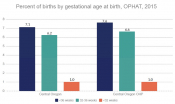Pregnancy and Maternal Health Data
The health of a child begins with a healthy mother and a healthy pregnancy. Factors like not using tobacco, alcohol, or other drugs, maintaining a healthy weight, receiving prenatal care, maintaining good oral health, breastfeeding, and preventing injuries and adverse childhood experiences (ACEs) are key for starting an infant's life in a healthy manner.
In 2017, we updated the 2015 Central Oregon Regional Health Assessment (RHA) with new data. This page provides an overview of updated data on maternal health and pregnancy. Please read through the information below, or download the maternal health and pregnancy overview handout from the supporting documents section at the bottom of the page.
You can find additional data related to maternal health and pregnancy, as well as information on a variety of other health topics in the Regional Health Assessment Midpoint Update document.

Percent of births by gestational age (CLICK FOR LARGER IMAGE)
We use Oregon Vital Statistics data to monitor characteristics of births, including how many babies in our community are born preterm. Around 7% of babies in Central Oregon were born preterm (<36 weeks) in 2015. Since the 2015 RHA was published, the percent of total births that were preterm (less than 36 weeks, or 32-36 weeks) decreased among Central Oregonians who were on the Oregon Health Plan. The percent of preterm births among Central Oregonians who were on the Oregon Health Plan is now similar to the percent among Oregonians as a whole.

Percent of mothers who smoked during pregnancy (CLICK FOR LARGER IMAGE)
We also use Oregon Vital Statistics data to monitor risk factors during pregnancy, including the percentage of women in our community who smoke during pregnancy. Around 8% of women in Deschutes County smoked during pregnancy, which is lower than across the state as a whole (10%).

Prevalence of gestational diabetes(CLICK FOR LARGER IMAGE)
Gestational diabetes is another risk factor during pregnancy that we monitor using Oregon Vital Statistics data. The percent of births to women with gestational diabetes has been consistently lower in Central Oregon than in Oregon since 2004. In 2015, the percent of births to women with gestational diabetes was statistically lower in Central Oregon than in Oregon as a whole.
Prenatal Care
We also use Oregon Vital Statistics data to monitor how many women use prenatal care during their pregnancies, the adequacy of this prenatal care, and in which trimester they started to receive this prenatal care. Most women (83.1%) in Deschutes County who had babies started prenatal care during their first trimester, which is higher than the percentage seen among women across the state of Oregon as a whole (79.0%). Since the 2015 RHA was published:
- The adequacy of prenatal care (as measured by the Kotelchuck Index) is now statistically lower in Jefferson County than in Oregon as a whole.
- The percentage of births for which prenatal care was started in the 1st trimester is still statistically lower in Jefferson County than in Oregon as a whole.
- The percentage of births for which prenatal care was started in the 2nd or 3rd trimester was statistically lower in Deschutes County than in Oregon as a whole.
